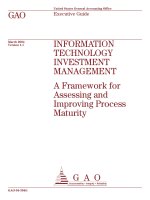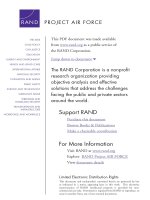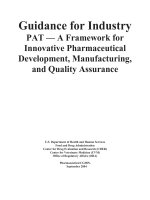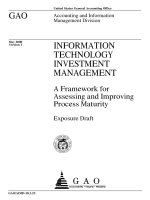INFORMATION TECHNOLOGY INVESTMENT MANAGEMENT: A Framework for Assessing and Improving Process Maturity pot
Bạn đang xem bản rút gọn của tài liệu. Xem và tải ngay bản đầy đủ của tài liệu tại đây (1.02 MB, 142 trang )
a
GAO
United States General Accounting Office
Executive Guide
March 2004
Version 1.1
INFORMATION
TECHNOLOGY
INVESTMENT
MANAGEMENT
A Framework for
Assessing and
Improving Process
Maturity
GAO-04-394G
www.gao.gov/cgi-bin/getrpt?GAO-04-394G.
To view the full product, click on the link
above. For more information, contact
David Powner, 202-512-4299,
, or Lester Diamond, 202-
512-7957,
Highlights of GAO-04-394G, an executive
guide.
March 2004
INFORMATION TECHNOLOGY
INVESTMENT MANAGEMENT
A Framework for Assessing and
Improving Process Maturity
The ITIM framework is a maturity model composed of five progressive
stages of maturity that an agency can achieve in its IT investment
management capabilities. These maturity stages are cumulative; that is, in
order to attain a higher stage of maturity, the agency must have
institutionalized all of the requirements for that stage in addition to those for
all of the lower stages. The framework can be used both to assess the
maturity of an agency’s investment management processes and as a tool for
organizational improvement. For each maturity stage, the ITIM describes a
set of critical processes that must be in place for the agency to achieve that
stage. The figure below shows the five stages and lists the critical processes
for each stage.
A
t the Stage 1 level of maturity, an agency is selecting investments in an
unstructured, ad hoc manner. Project outcomes are unpredictable and
successes are not repeatable; the agency is creating awareness of the
investment process. Stage 2 critical processes lay the foundation for sound
IT investment processes by helping the agency to attain successful,
p
redictable, and repeatable investment control processes at the project level.
Stage 3 represents a major step forward in maturity, in which the agency
moves from project-centric processes to a portfolio approach, evaluating
p
otential investments by how well they support the agency’s missions,
strategies, and goals. At Stage 4, an agency uses evaluation techniques to
improve its IT investment processes and its investment portfolio. It is able to
p
lan and implement the “de-selection” of obsolete, high-risk, or low-value IT
investments. The most advanced organizations, operating at Stage 5
maturity, benchmark their IT investment processes relative to other “best-in-
class” organizations and look for breakthrough information technologies
that will enable them to change and improve their business performance.
The ITIM Stages of Maturity with Critical Processes
In 2000, GAO published an
exposure draft of Information
Technology Investment
Management: A Framework for
Assessing and Improving Process
Maturity (ITIM). Built around the
select/control/evaluate approach
described in the Clinger-Cohen Act
of 1996—which establishes
statutory requirements for IT
management—the framework
provides a method for evaluating
and assessing how well an agency
is selecting and managing its IT
resources. The exposure draft
reflected current accepted or best
practices in IT investment
management, as well as the
reported experience of federal
agencies and other organizations in
creating their own investment
management processes. This new
version updates the exposure draft
to take into account comments that
GAO has received; GAO’s
experiences in evaluating several
agencies’ implementations of
investment management processes
and the lessons learned by these
agencies; and the importance of
enterprise architecture (EA) as a
critical frame of reference in
making IT investment decisions.
Using the framework to analyze an
agency’s IT investment
management processes provides:
(1) a rigorous, standardized tool for
internal and external evaluations of
these processes; (2) a consistent
and understandable mechanism for
reporting the results of
assessments; and (3) a road map
that agencies can follow in
improving their processes.
Page i GAO-04-394G GAO IT Investment Management Framework
Contents
Preface
1
Section 1: Introduction
5
Changes from the Exposure Draft 6
Investment Management Overview 7
Section 2: Overview of
ITIM
11
The Stages of Maturity 11
Progressing through the Stages of Maturity 15
Section 3: Components
of ITIM
21
ITIM Hierarchy 21
Section 4: Uses of ITIM
23
Principles Guiding the Use and Interpretation of the Framework 23
Tool for Organizational Improvement 24
Tool for Assessing the Maturity of an Organization 26
Limitations and Boundaries 27
Section 5: Critical
Processes for the ITIM
Stages
29
Stage 1: Creating Investment Awareness 30
Stage 2: Building the Investment Foundation 33
Stage 3: Developing a Complete Investment Portfolio 63
Stage 4: Improving the Investment Process 90
Stage 5: Leveraging Information Technology for Strategic
Outcomes 102
Appendixes
Appendix I: Glossary 113
Appendix II: Conducting an ITIM Assessment 121
Using ITIM to Assess IT Investment Decision-Making
Processes 121
Summary of ITIM Assessment Process 122
Appendix III: Acknowledgments 135
Contents
Page ii GAO-04-394G GAO IT Investment Management Framework
Figures
Figure 1: Fundamental Phases of the IT Investment Approach 8
Figure 2: The Five Stages of Maturity Within ITIM 11
Figure 3: Critical Maturation Steps Required to Move to the Next
Stage 16
Figure 4: The Components of an ITIM Critical Process 22
Figure 5: The ITIM Stages of Maturity with Critical Processes 29
Figure 6: The ITIM Stages of Maturity with No Stage 1 Critical
Processes 30
Figure 7: The ITIM Stages of Maturity with Stage 2 Critical
Processes 33
Figure 8: Instituting the Investment Board 35
Figure 9: Meeting Business Needs 41
Figure 10: Selecting an Investment 46
Figure 11: Providing Investment Oversight 51
Figure 12: Capturing Investment Information 58
Figure 13: The ITIM Stages of Maturity with Stage 3 Critical
Processes 63
Figure 14: Defining the Portfolio Criteria 65
Figure 15: Creating the Portfolio 71
Figure 16: Evaluating the Portfolio 78
Figure 17: Conducting Postimplementation Reviews 84
Figure 18: The ITIM Stages of Maturity With Stage 4 Critical
Processes 90
Figure 19: Improving the Portfolio’s Performance 92
Figure 20: Managing the Succession of Information Systems 97
Figure 21: The ITIM Stages of Maturity with Stage 5 Critical
Processes 102
Figure 22: Optimizing the Investment Process 104
Figure 23: Using IT to Drive Strategic Business Change 109
Figure 24: Phases in an ITIM Assessment 122
This is a work of the U.S. government and is not subject to copyright protection in the
United States. It may be reproduced and distributed in its entirety without further
permission from GAO. However, because this work may contain copyrighted images or
other material, permission from the copyright holder may be necessary if you wish to
reproduce this material separately.
Page 1 GAO-04-394G GAO IT Investment Management Framework
Preface
Investments in information technology (IT) can enrich people’s lives and
improve organizational performance. For example, during the last decade
the Internet has matured from being a means for academics and scientists
to communicate with each other to a national resource where citizens can
interact with their government in many ways, for example, by receiving
services, supplying and obtaining information, asking questions, and
providing comments on proposed rules. Although they have the potential to
improve lives and organizations, IT projects can also become risky, costly,
unproductive mistakes. As we have described in numerous reports and
testimonies, federal IT projects too frequently incur cost overruns and
schedule slippages while contributing little to mission-related outcomes.
The Paperwork Reduction Act (PRA)
1
requires federal agencies to be
accountable for their IT investments and responsible for maximizing the
value and managing the risks of their major information systems initiatives.
The Clinger-Cohen Act of 1996
2
establishes a more definitive framework for
implementing the PRA’s requirements for IT investment management. It
requires federal agencies to focus more on the results they have achieved
through IT investments, while concurrently improving their IT acquisition
processes. The Clinger-Cohen Act
3
also introduces more rigor and structure
into how agencies are to select and manage IT projects. Among other
things, it lays out specific aspects of the process that agency heads are to
implement in order to maximize the value of the agency’s IT investments
and assess, manage, and evaluate the risks of its IT acquisitions.
4
The
E-Government Act of 2002
5
provides additional guidance on IT
management practices across federal agencies.
Through our research into IT management best practices and our
evaluation of agency IT management performance, we have identified a set
of essential and complementary management disciplines. These include
1
44 U.S.C. § 3506(h).
2
The fiscal year 1997 Omnibus Consolidated Appropriations Act, Pub. L. 104-208, renamed
both Division D (the Federal Acquisition Reform Act) and E (the Information Technology
Management Reform Act) of the 1996 DOD Authorization Act, Pub. L. 104-106, as the
Clinger-Cohen Act of 1996.
3
40 U.S.C. §§ 11312-11313.
4
44 U.S.C. § 3506(h)(5); 40 U.S.C. §§ 11312-11313.
5
E-Government Act of 2002, Public Law 107-347 (Dec. 17, 2002).
Preface
Page 2 GAO-04-394G GAO IT Investment Management Framework
• investment management,
• strategic planning,
• software/system development and acquisition management,
• IT services acquisition management,
• human capital management,
• information security management, and
• enterprise architecture management.
Using the results of this research and evaluation, we have developed
various management frameworks and guides. In 1997 we developed
guidance,
6
based primarily on the Clinger-Cohen Act, that provides a
method for evaluating and assessing how well a federal agency is selecting
and managing its IT resources. This guidance also identifies specific areas
where improvements can be made. The Information Technology
Investment Management (ITIM) Framework enhances this guidance by
identifying critical processes for successful investment and organizing
these processes into a framework of increasingly mature stages.
Maturity models have been proven to be a highly effective evaluative
technique for the Software Engineering Institute, which is well regarded for
its collection of Capability Maturity Models
SM
(e.g., Capability Maturity
Model for Software).
7,8
Other researchers have proposed similar
approaches based on maturity models.
9
6
U.S. General Accounting Office, Assessing Risk and Returns: A Guide for Evaluating
Federal Agencies’ IT Investment Decision-making, GAO-AIMD-10.1.13 (Washington, D.C.:
February 1997).
7
Capability Maturity Model is a service mark of Carnegie Mellon University.
8
M. Paulk et al., Capability Maturity Model for Software (Version 1.1), SEI-93-TR-024.
9
Giga Information Group, Inc., Total Economic Impact, Part 2: Defining and Measuring IT
Value (P-1297-009).
Preface
Page 3 GAO-04-394G GAO IT Investment Management Framework
The maturity framework approach generally
• offers a comprehensive model for assessing process capability within an
organization;
• can be applied to multiple types of disciplines, such as IT asset
acquisition, human capital, and systems engineering; and
• can serve as a valuable tool for organizations to use to improve their
technical development and management processes.
The initial ITIM exposure draft that we issued in May 2000
10
reflected both
a maturation of thinking in the area of IT investment management and
input we had received from organizations and federal agencies based on
their experiences in creating their own investment mechanisms and
processes. This updated version has been modified based on comments we
received on the initial exposure draft and on our experiences in evaluating
and learning from agencies that are implementing investment management
processes. Moreover, this version of the ITIM is consistent with and
supports other maturity frameworks, including GAO’s Enterprise
Architecture Management Maturity Framework (EAMMF).
11
Among other
things, this version of the ITIM addresses the importance of an enterprise
architecture (EA) as a critical frame of reference for organizations when
they are making IT investment decisions.
The ITIM can be used to analyze an organization’s investment management
processes and to determine its level of maturity. Since its release in
exposure draft in May, 2000, the ITIM has been GAO’s primary tool for
evaluating investment management capabilities. In addition, a number of
agencies have used the framework as they worked to improve their
investment processes.
If you have any questions about the Information Technology Investment
Management Framework or the IT investment management approach,
10
U.S. General Accounting Office, Information Technology Investment Management: A
Framework for Assessing and Improving Process Maturity, Exposure Draft, GAO-AIMD-
10.1.23 (Washington, D.C.: May 2000).
11
U.S. General Accounting Office, Information Technology: A Framework for Assessing
and Improving Enterprise Architecture Management (Version 1.1), GAO-03-584G
(Washington, D.C.: April 2003).
Preface
Page 4 GAO-04-394G GAO IT Investment Management Framework
please contact me at (202) 512-4299 or ; or Lester
Diamond, Assistant Director at (202) 512-7957 or Other
key contributors to this report were Joanne Fiorino, Sabine R. Paul,
Tomas Ramirez, Thomas Wright, and Neil Doherty.
David A. Powner
Director, Information Technology Management Issues
Page 5 GAO-04-394G GAO IT Investment Management Framework
Section 1: Introduction
The Information Technology Investment Management Framework
identifies—and organizes into a framework of increasingly mature stages—
thirteen processes that are critical for successful investment. The original
exposure draft of ITIM expanded the widely accepted federal management
framework for IT investment decision making that was embodied in OMB
and GAO guidance
12
and shifted the content from a guidance-based focus to
an activity- and maturity-based focus. Such a maturity framework can be
used either to analyze an organization’s investment management process or
to determine the maturity of its investment process. The framework
provides three key capabilities that are of use to many federal agencies:
(1)
a rigorous, standardized tool for internal and external evaluations of an
agency’s IT investment management process; (2)
a consistent and
comprehensible mechanism for reporting the results of these assessments
to agency executives, the Congress, and other interested parties; and (3)
a
road map that agencies can use for improving their investment
management processes. It should be noted, however, that an organization’s
achievement of more mature investment management stages depends on
its instituting other good management practices and attributes, such as
strategic planning, project management, enterprise architecture (EA)
management, human capital management, and software and system
acquisition management.
In May 2000 we released an exposure draft of the ITIM framework for trial
and comment. Since that time, the framework has been used by a number
of federal agencies in developing and enhancing their investment
management strategies. In addition, we have used it to evaluate several
12
Evaluating Information Technology Investments, A Practical Guide, Executive Office of
the President, Office of Management and Budget, November 1995, and U.S. General
Accounting Office, Assessing Risks and Returns: A Guide for Evaluating Federal
Agencies’ IT Investment Decision-making, GAO/AIMD-10.1.13 (Washington D.C.:
February 1997).
Section 1: Introduction
Page 6 GAO-04-394G GAO IT Investment Management Framework
agencies.
13
This release includes lessons learned from our use of the
framework in these evaluations and from lessons conveyed to us by users
of the framework at a number of agencies. In order to validate the
appropriateness of our changes and to gain the advantage of their
experience, we provided this release for review to several outside experts
who are familiar with the ITIM exposure draft and with investment
management in a broad array of organizations, both public and private.
This version also includes a much fuller description of the relationship
between ITIM and EA. Based on our experience, employing ITIM and EA in
concert can greatly increase the chances that an organization’s operational
and IT environments will be pursued in a way that optimizes mission
performance. The EA provides a clear and comprehensive picture of the
structure of an entity, whether it is an organization or a functional or
mission area. It defines an organization’s operations in logical (i.e.,
information flows) as well as technical terms (i.e., hardware and software).
The EA also describes these perspectives both for the organization’s
current or “as-is” environment and for its target or “to-be” environment as
well as for a transition or sequencing plan for moving from the “as-is” to the
“to-be” environment.
Changes from the
Exposure Draft
Stage 2 has been the primary beneficiary of the lessons learned from the
use of the framework, because most agencies that we have evaluated are
still operating at Stage 2. In Stage 2 we have tried to clarify aspects of
critical processes that previously have led to diverse interpretations. In
addition, we have moved what was previously the critical process for
Authority Alignment of IT Investment Boards from Stage 3 in the exposure
draft into Stage 2 in this release; it is now part of the critical process for
Instituting the Investment Board. Through our work, we have found that
13
U.S. General Accounting Office, Information Technology: INS Needs to Strengthen Its
Investment Management Capability, GAO-01-146 (Washington, D.C.: Dec. 29, 2000);
Information Technology: DLA Needs to Strengthen Its Investment Management
Capability, GAO-02-314 (Washington, D.C.: Mar. 15, 2002); United States Postal Service:
Opportunities to Strengthen IT Investment Management Capabilities, GAO-03-3
(Washington D.C.: Oct. 15, 2002); U.S. General Accounting Office, Bureau of Land
Management: Plan Needed to Sustain Progress in Establishing IT Investment
Management Capabilities, GAO-03-1025 (Washington, D.C.: Sept. 12, 2003); U.S. General
Accounting Office, Information Technology: Departmental Leadership Crucial to Success
of Investment Reforms at Interior, GAO-03-1028 (Washington, D.C.: Sept. 12, 2003).
Section 1: Introduction
Page 7 GAO-04-394G GAO IT Investment Management Framework
instituting multiple boards was not unusual for organizations working in
Stage 2 and that these boards occasionally were not well aligned.
Stage 3 has been enhanced to better explain the organization and use of
portfolio management for investments. In this area we gained knowledge
from the experiences of others, both directly from individuals using IT
portfolio management in agencies as well as from literature that has been
released during the last few years. In addition, we moved the critical
process for Postimplementation Review and Feedback from Stage 4 in the
exposure draft to Stage 3 in this release. We did this so we could ensure
that organizations that have completed Stage 3 are meeting the requirement
for having selection, control, and evaluation processes in place, as required
by the Clinger-Cohen Act.
Stages 4 and 5 have been modified only to reflect new names for critical
processes and to relocate to Stage 3 the critical process for
Postimplementation Review and Feedback. We have not gained substantial
new experience in these stages, because few organizations are operating at
these levels of maturity. We anticipate modifying these stages in the future,
when we have learned more from organizations’ experiences.
Investment
Management Overview
A central tenet of the federal approach to IT investment management has
been the select/control/evaluate model. This model was initially identified
in our Strategic Information Management (SIM) Executive Guide,
14
expanded in the Office of Management and Budget’s IT investment
guidance,
15
and then refined in our subsequent guidance.
16
It provides a
systematic method for agencies to minimize risks while maximizing the
returns of investments. Figure 1 illustrates the central components of this
model.
14
U.S. General Accounting Office, Executive Guide: Improving Mission Performance
Through Strategic Information Management and Technology, GAO/AIMD-94-115
(Washington, D.C.: May 1994).
15
Evaluating Information Technology Investments, A Practical Guide, Executive Office of
the President, Office of Management and Budget, November 1995.
16
U.S. General Accounting Office, Assessing Risks and Returns: A Guide for Evaluating
Federal Agencies’ IT Investment Decision-making, GAO/AIMD-10.1.13 (Washington, D.C.:
February 1997).
Section 1: Introduction
Page 8 GAO-04-394G GAO IT Investment Management Framework
Figure 1: Fundamental Phases of the IT Investment Approach
During the select phase the organization (1) identifies and analyzes each
project’s risks and returns before committing significant funds to any
project and (2)
selects those IT projects that will best support its mission
needs. This process should be repeated each time funds are allocated to
projects, reselecting even ongoing investments as described below.
During the control phase the organization ensures that, as projects develop
and investment expenditures continue, the project continues to meet
mission needs at the expected levels of cost and risk. If the project is not
meeting expectations or if problems have arisen, steps are quickly taken to
address the deficiencies. If mission needs have changed, the organization is
able to adjust its objectives for the project and appropriately modify
expected project outcomes.
During the evaluate phase, actual versus expected results are compared
after a project has been fully implemented. This is done to (1)
assess the
project’s impact on mission performance, (2)
identify any changes or
modifications to the project that may be needed, and (3)
revise the
investment management process based on lessons learned.
The investment process does not end with the evaluation phase. A project
can be active concurrently in more than one phase of the
select/control/evaluate model. After a project has been designated for
Source: GAO.
Select phase
- Screen
- Rank
- Choose
Evaluate phase
- Conduct interviews
- Make adjustments
- Apply lessons learned
Control phase
- Monitor progress
- Take corrective actions
How are you
ensuring that
projects deliver
benefits?
Are the systems
delivering what
you expected?
How do you know
that you have
selected the best
projects?
S
e
l
e
c
t
Data
flow
C
o
n
t
r
o
l
E
v
a
l
u
a
t
e
Section 1: Introduction
Page 9 GAO-04-394G GAO IT Investment Management Framework
initial funding in the select phase, it becomes the subject of evaluation
throughout the control phase for the purposes of reselection. Reselection is
an ongoing process that continues for as long as a project is receiving
funding. If a project is not meeting the goals and objectives that were
originally established when it was selected, or if the goals have been
modified to reflect changes in mission objectives—and corrective actions
are not succeeding—a decision must be made on whether to continue to
fund the project. Ultimately, “deselection” can be one of the most difficult
steps to implement, but it is necessary if funds can be better utilized
elsewhere. Once projects are operating and being maintained, they remain
under constant review for reselection.
Section 1: Introduction
Page 10 GAO-04-394G GAO IT Investment Management Framework
Page 11 GAO-04-394G GAO IT Investment Management Framework
Section 2: Overview of ITIM
The Stages of Maturity
ITIM is comprised of five stages of maturity. Each stage builds upon the
lower stages and enhances the organization’s ability to manage its IT
investments. Figure
2 shows the five ITIM stages and gives a brief
description of each stage.
Figure 2: The Five Stages of Maturity Within ITIM
Stage 1: Creating Investment
Awareness
Stage 1 is characterized by ad hoc, unstructured, and unpredictable
investment processes. For example, in a Stage 1 organization, there is
generally little relationship between the success or failure of one project
and the success or failure of another project. If an IT project succeeds and
is seen as a good investment, it is largely due to exceptional actions on the
part of the project team, and thus its success might be difficult to repeat.
Investment processes that are important for success may be known, but
only to isolated teams; this process knowledge is not widely shared or
institutionalized.
Most organizations with Stage 1 maturity have some type of project
selection process in place as part of their annual budgeting activity.
Source: GAO.
The organization is focused on evaluation techniques to improve its
IT investment processes and portfolio(s), while maintaining mature
selection and control techniques.
The organization has mastered the selection, control, and evaluation
processes and now seeks to shape its strategic outcomes by
benchmarking its IT investment processes relative to other
"best-in-class" organizations.
Stage 5: Leveraging IT for
strategic outcomes
Maturity Stages
Enterprise and Strategic Focus
Project-centric
Description
Stage 4: Improving the
investment process
Stage 3: Developing a complete
investment portfolio
Stage 2: Building the investment
foundation
Stage 1: Creating investment awareness
The organization has developed a well-defined IT investment portfolio using
an investment process that has sound selection criteria and maintains
mature, evolving, and integrated selection, control, and evaluation
processes.
Basic selection capabilities are being driven by the development of
project selection criteria, including benefit and risk criteria, and an
awareness of organizational priorities when identifying projects for
funding. Executive oversight is applied on a project-by-project basis.
Ad hoc, unstructured, and unpredictable investment processes
characterize this stage. There is generally little relationship between
the success or failure of one project and the success or failure of
another project.
Section 2: Overview of ITIM
Page 12 GAO-04-394G GAO IT Investment Management Framework
However, the selection process is frequently rudimentary, poorly
documented, and inconsistently applied.
The unstructured and unpredictable investment processes that
characterize a Stage 1 organization also mean that even if it recognizes that
a given project is in trouble, it may not have adequate processes to
consistently address and resolve the project’s problems. Additionally, a
focus on project results in terms of business benefits is often missing in
these organizations.
Stage 2: Building the
Investment Foundation
One focus of Stage 2 maturity is to establish basic selection capabilities.
Basic selection capabilities are driven by the development of project
selection criteria, including benefit and risk criteria, and an awareness of
organizational priorities when identifying projects for funding. No longer
are projects being funded solely on an ad hoc basis. The basic selection
processes established in Stage 2 lay the foundation for more mature
selection capabilities in Stage 3. Therefore, the organization also focuses
on defining and developing its IT investment board(s), identifying the
business needs or opportunities to be addressed by each IT project, and
using this knowledge in the selection of new IT proposals.
An organization working to complete Stage 2 should be starting to develop
an ITIM decision-making process that utilizes its EA—to the extent that an
EA exists. An organization’s “as-is” architecture may provide some of the
basic information that is needed by decision makers, such as what systems
currently exist and what potential functional overlap may occur with a new
investment. In addition, an organization’s EA tool may serve as a repository
for investment information, although this may require modifying the
manner in which the tool is currently being used. Criteria for selecting new
and ongoing investments should be established, and the requirement to
comply with the target EA may serve as an important guide in investment
decisions. In addition, to gain further confidence that each investment is
providing specific value to the organization, an organization’s policies and
procedures should provide for identifying the business needs and the
associated users of each IT project.
An equally important focus is to attain repeatable, successful IT investment
control techniques at the project level. For an organization to develop a
sound IT investment process, it must first be able to control its investments
so that they finish predictably within established schedule and budget
ranges. In addition, it must be able to identify potential exposures to risk
Section 2: Overview of ITIM
Page 13 GAO-04-394G GAO IT Investment Management Framework
and put in place strategies to mitigate that risk. In the absence of
predictable, repeatable, and reliable investment control processes, selected
investments will be subject to a higher risk of failure despite rigorous
analysis of the estimates used to justify them. Further, the absence of
repeatable control processes will result in ineffective evaluation processes
and contradictory efforts at process improvement.
To ultimately succeed, most IT investments require a relentless focus on
interim results and successful risk management strategies, among other
things. Taking this into account, an organization can begin by (1)
focusing
on gaining control of its existing collection of projects and (2)
following a
disciplined process for improving project outcomes over time by regularly
tracking and overseeing each project’s cost and schedule milestones and by
monitoring expected benefits and risks. Supporting these activities
requires collecting investment information to ensure that the organization
knows fundamental facts about its IT assets, such as their location, cost,
and ownership.
Stage 3: Developing a
Complete Investment
Portfolio
Stage 3 critical processes depend specifically on the successful
implementation of Stage
2 critical processes. In order to operate
successfully at Stage 3, the organization must have in place the structure
and repeatability of the project-centric management processes described
above. In addition, the project-specific performance data being used for
oversight and reselection in Stage
2 are crucial for the successful
management of the investment portfolio. The critical focus for Stage
3
maturation is to establish a consistent, well-defined perspective on the IT
investment portfolio and to maintain mature, integrated selection (and
reselection), control, and evaluation processes. These processes will be
evaluated during postimplementation reviews (PIR). Once IT projects have
been selected and are meeting their scheduled performance expectations—
as outlined in Stage
2—the organization needs to develop an IT investment
portfolio using an investment process that is consistent with its EA and
employs sound selection criteria.
The development and use of portfolio selection criteria enable the
organization to expand its focus from being primarily project-oriented to
including the broader portfolio perspective. The portfolio perspective
drives the organization to focus on the benefits gained from the synergies
to be found among the investments in the entire collection, rather than just
from the sum of the individual investments. Instead of focusing exclusively
on the balance between the costs and benefits of individual investments, in
Section 2: Overview of ITIM
Page 14 GAO-04-394G GAO IT Investment Management Framework
Stage 3 decision makers also must consider the interaction among
investments and the contribution to organizational mission goals and
strategies that could be made by alternative portfolio selections. The
development of the portfolio selection criteria communicates
organizational priorities to the IT project management community and
ensures that each investment submitted for funding supports the
organization’s mission, strategies, and goals, as well as project-specific
outcomes. The critical process for Creating the Portfolio describes how the
organization should use the portfolio selection criteria to develop an IT
investment portfolio. Individual investments are reviewed and evaluated
following their implementation in order to compare actual results with
performance expectations.
An organization’s policies and procedures should provide for specifying the
relationship between its architecture and its investment decision-making
authority. The links between the EA and the investment portfolio should be
explicitly defined. In addition, when operating at this stage, organizations
should be working to align their EA with their IT portfolio selection
criteria.
Stage 4: Improving the
Investment Process
An organization at Stage 4 maturity is focused on using evaluation
techniques to improve its IT investment processes and portfolio(s) while
maintaining mature control and selection processes. At this stage, the
organization should also regularly analyze its investment portfolio(s) to
ensure that its investments continue to be aligned with the most current
version of its architecture, since small changes in either an investment
itself or in the EA may have occurred over time without being recognized in
periodic selection/reselection decisions. As described in Stage 3,
postimplementation reviews typically identify lessons learned from an
investment and determine whether the benefits anticipated in the business
case for the investment have been achieved. Analyzing a number of PIRs
serves as a basis for creating recommendations for changing and improving
IT investment processes.
Section 2: Overview of ITIM
Page 15 GAO-04-394G GAO IT Investment Management Framework
Portfolio categories are used to organize the lessons learned and the
recommendations gleaned both from PIRs conducted during Stage 3 and
from other sources of process or investment information. The information
within these categories is then used to fine-tune the investment processes
and the portfolios. Additionally, at Stage 4 maturity the organization has the
capacity to conduct IT succession activities and thus can plan and
implement the “deselection” of obsolete, high-risk, or low-value IT
investments.
Stage 5: Leveraging
Information Technology for
Strategic Outcomes
Once an organization has mastered the selection, control, and evaluation
processes, it seeks to shape its strategic outcomes by (1)
using its EA as a
critical frame of reference to ensure alignment with the target architecture,
(2)
learning from other organizations, (3) continuously improving the
manner in which it uses IT to support and improve its business outcomes,
and (4)
focusing on flexibility and becoming a more agile organization that
relies on its architecture for its vision of the future and the ITIM as a critical
means for implementing it. Thus, an organization with Stage
5 maturity
benchmarks its IT investment processes relative to other “best-in-class”
organizations and conducts proactive monitoring for breakthrough
information technologies that will allow it to significantly change and
improve its business performance.
Progressing through
the Stages of Maturity
Within ITIM, lower maturity stages provide the foundation for higher
maturity stages. Thus, an organization increases its IT investment maturity
and management capability as it progresses through the ITIM maturity
stages. The following section describes the critical maturation steps that
occur as an organization moves from one stage to the next (see fig. 3).
Section 2: Overview of ITIM
Page 16 GAO-04-394G GAO IT Investment Management Framework
Figure 3: Critical Maturation Steps Required to Move to the Next Stage
Moving from Stage 1 to
Stage 2
Investment control processes are the essential proficiencies that an
organization establishes as it moves from ITIM Stage 1 to Stage 2. As
investment control processes become better established,
• one or more investment board(s) is created to oversee and select IT
projects;
• investment information such as costs, benefits, schedule, risk
assessments, performance metrics, and system functionality is collected
to support executive decision making;
• the organization gains a better perspective on the IT projects in which it
is investing;
Source: GAO.
Stage 1:
Creating
investment
awareness
Stage 2:
Building the
investment
foundation
- An investment board is established to drive the investment process.
- Business needs are identified for each project.
- An investment selection process is developed.
- Board oversees the progress of individual projects.
- Investment information is collected and disseminated.
Stage 4:
Improving the
investment
process
Stage 3:
Developing a
complete
investment portfolio
- Criteria are developed for identifying investments that best fit
with the portfolio.
- The portfolio is developed through the use of categorization when
comparing investments.
- Performance reviews are conducted both during and after implementation.
- The organization learns from and adopts the tools, techniques,
or methods used by best-in-class external organizations.
- Changes to strategic business processes are driven by the
capabilities of identified information technologies.
Stage 5:
Leveraging IT
for strategic
outcomes
- Evaluation techniques are being used to improve the investment
processes and the portfolio.
- Succession management processes are developed for retaining or
disposing of investments.
Section 2: Overview of ITIM
Page 17 GAO-04-394G GAO IT Investment Management Framework
• communicating the status of ongoing projects improves
organizationwide system acquisition, development, and management
practices;
• the organization creates and maintains better project-level cost
information; and
• key customers (or end users) and business needs for each IT project are
identified, and the users are engaged in this process.
Critical to maturing project-level IT investment control processes is the
ability to recognize the need for and to take swift corrective action when a
project is having trouble meeting its schedule expectations and cost
estimates. As it moves through Stage 2, an organization develops robust
methods to collect data from the project-level management processes and
aggregate it appropriately to provide executive management with the
information it needs to execute its oversight responsibilities. As the
organization matures, it also learns from past decisions and better manages
the causal factors that created past problems, thus improving the
performance results of ongoing projects.
Beyond investment control processes, the organization also begins to
implement basic selection processes. The core business needs for each IT
project are identified and the basic portfolio development processes are
used to select new IT proposals.
Moving from Stage 2 to
Stage 3
Creation of a mature IT process for selecting investments is the major
accomplishment that an organization demonstrates as it moves from
Stage 2 to Stage 3 maturity. In addition, well-developed investment control
processes lead to greater certainty about future IT investment outcomes
and greater confidence that IT investments, when they are selected, will
achieve their expected cost, schedule, and performance goals, as well as
their expected functionality. Thus, once the investment control processes
have been established, an organization can build on these fundamental
investment processes to create mature portfolio selection processes.
Mature selection processes include
• the creation and maintenance of portfolio selection criteria,
• the analysis associated with examining the merits of each IT investment
in the context of the portfolio,
Section 2: Overview of ITIM
Page 18 GAO-04-394G GAO IT Investment Management Framework
• the use of an EA to help align IT investments with strategic objectives,
and
• the grouping of similar investments together and the development of the
portfolio.
Beyond the creation of a mature selection process, the organization now
refines the elements of benefit and risk management in its investment
control process, because it has installed the supporting tools for doing so
as its selection process matures. Individual investments are reviewed and
evaluated following their implementation and are judged based on how
well they meet their performance expectations.
Moving from Stage 3 to
Stage 4
As an organization reaches Stage 4 maturity, it has created mature IT
investment evaluation processes and established a complete IT investment
management process. In this stable environment, the organization can take
the lessons it has learned from evaluating its investment processes (i.e.,
based on postimplementation reviews in Stage 3) and change these
processes with predictably beneficial results. By doing so, it also creates
the environment and the mechanisms for continuous improvement in
Stage 5. In addition to improving its investment processes, an organization
operating in Stage 4 can manage resource succession—that is, “de-
selecting” current IT investments—by migrating to successor investments
or retiring obsolete and low-performing ones and by making these
decisions in the context of the portfolio created in Stage 3 and a well
understood EA sequencing plan and “to-be” architecture. Together, the
portfolio, sequencing plan, and “to-be” architecture provide a full picture
of the current state of an organization’s investments, its vision of the future,
and its plan for getting there. In this context, the obsolescence of systems
can be anticipated, and the declining benefits of specific systems can be
viewed in the light of alternative investments.
Section 2: Overview of ITIM
Page 19 GAO-04-394G GAO IT Investment Management Framework
Moving from Stage 4 to
Stage 5
An organization that is moving from Stage 4 to Stage 5 has mature
selection, control, and evaluation processes in place. It now seeks ways to
(1) institutionalize the continuous improvement of these processes and
(2)
improve its strategic business outcomes. It accomplishes these goals by
examining and learning from other organizations by means of
benchmarking. Benchmarking is used because there may be external
organizations with specific processes that are more innovative or more
efficient than its own processes. Beyond benchmarking, the organization
leverages IT to significantly change and improve its business performance
and outcomes.
Section 2: Overview of ITIM
Page 20 GAO-04-394G GAO IT Investment Management Framework
Page 21 GAO-04-394G GAO IT Investment Management Framework
Section 3: Components of ITIM
ITIM Hierarchy
Like other maturity models, ITIM is subdivided into a hierarchy. Each
maturity stage consists of critical processes that are composed of a number
of key practices. These hierarchical components are described below.
Maturity Stages
Each of the four maturity stages beyond Stage 1 is a plateau of well-defined
critical processes. The five maturity stages represent the steps toward
achieving a mature, comprehensive IT investment management process.
Critical Processes
With the exception of Stage 1, each maturity stage is composed of multiple
critical processes, such as the processes used to create an IT investment
portfolio. Each critical process contains a set of key practices that, when
fulfilled, implement the critical process needed to attain a given maturity
stage.
Key Practices
The key practices are the tasks that must be performed by an organization
in order to implement and institutionalize a critical process effectively. Key
practices fall into three categories: organizational commitments,
prerequisites, and activities. An explanation and a description of the
relationship among these different types of key practices is shown in
figure 4. In Section 5, each key practice is listed, followed by commentary
and additional information that may assist an organization in
understanding or interpreting how it could be implemented.









